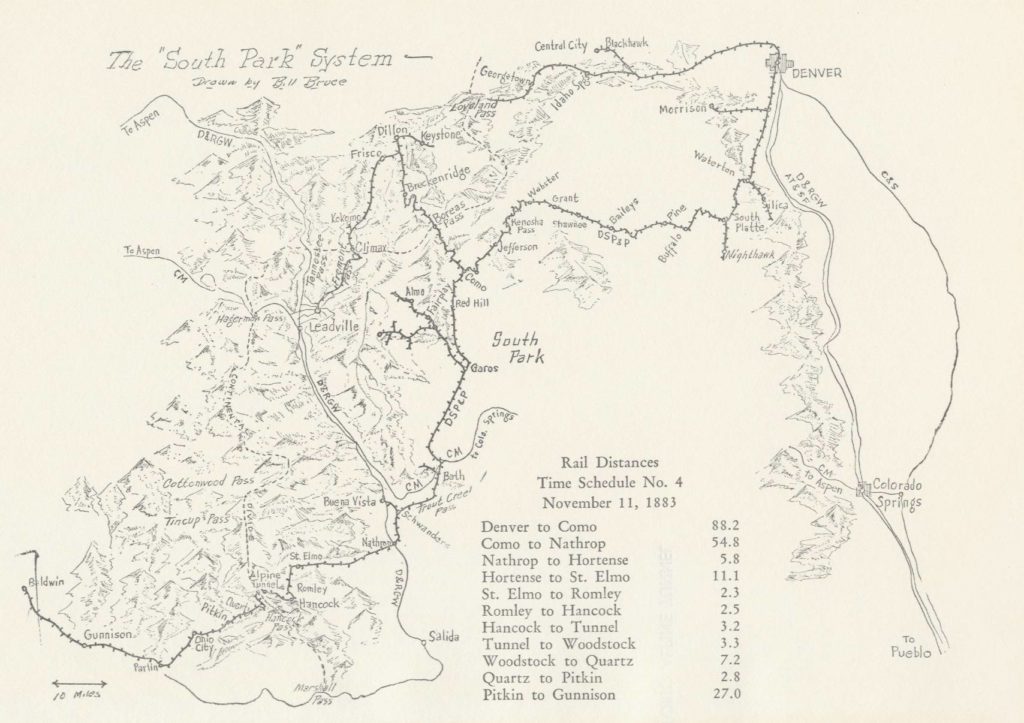 After living in Colorado off and on for over 20 years, we finally made a trip Colorado Springs to take the Pikes Peak Cog Railway. The weather was fairly nice for some great views while making the slow climb to the top of Pikes Peak.
After living in Colorado off and on for over 20 years, we finally made a trip Colorado Springs to take the Pikes Peak Cog Railway. The weather was fairly nice for some great views while making the slow climb to the top of Pikes Peak.
 After living in Colorado off and on for over 20 years, we finally made a trip Colorado Springs to take the Pikes Peak Cog Railway. The weather was fairly nice for some great views while making the slow climb to the top of Pikes Peak.
After living in Colorado off and on for over 20 years, we finally made a trip Colorado Springs to take the Pikes Peak Cog Railway. The weather was fairly nice for some great views while making the slow climb to the top of Pikes Peak.
Saint Elmo was known as a “Saturday Night Town” located near the Denver, South Park & Pacific railroad line. St. Elmo became a favorite place for miners and railroad workers.
The failure of numerous mines, and the closure of the Alpine Tunnel in 1910 started the decline of St. Elmo. The town officially died on Sept. 30, 1952, when the post office closed, but most residents left after the last mine closed in the 1930s.
Saint Elmo today has numerous structures that are still standing, but are all privately owned. Some of the surviving buildings include City Hall, built in 1882, with two small jail cells and an iron ball and chain attached to a boulder, and the school building, built in 1880. Located on the east side of main street was the location of the Town Hall as well as Stark family residences. These buildings were lost in a fire April 15 2002. There is currently a fund raiser to help rebuild the Town Hall. The Stark family was the last family to leave St. Elmo in 1958. The stark family owned the Home Comfort Hotel the telegraph office and Post Office. They also had a retail General Store to keep the miners with plenty of supplies.
From Beuna Vista, take US 285 south to Nathrop, and then County Road 162 west. Follow for approx. 16 miles to St. Elmo.
The Denver, South Park and Pacific Railroad was incorporated in Colorado Territory on June 16, 1873. This company constructed the lines from Denver to Leadville and Gunnison and also became controlled by the UP.
The DSP&P was sold at foreclosure to The Denver, Leadville & Gunnison Railway which was incorporated in Colorado on July 17, 1889, on July 17, 1889. The DL&G became part of the UP receivership on October 13, 1893.
The Denver, Leadville & Gunnison was acquired by The Colorado and Southern Railway on December 28, 1898. The Colorado and Southern Railway was an independent Company until control of the C&S was acquired by the CB&Q in 1908.
From that time on, the C&S had to march to Chicago’s tune and the 3′ gauge main line began disappearing, the first segment in 1910 with the closure of the Alpine Tunnel and the last segment on August 25, 1943 with the conversion to Standard Gauge of the Leadville to Climax branch.

Excavation of the Alpine Tunnel began in January 1880. At an altitude of 11,523 feet, it became the first tunnel constructed through the Continental Divide, and was expected to be finished in only six months. However, due to unforeseen circumstances and construction taking place in the dead of winter, the task required nearly two years to complete. Fractured granite necessitated the expense of using over 400,000 board feet of California redwood to support and encase 1,427 feet of the 1,772 foot long tunnel with a total cost of around $300,000.
The first train went through the Alpine Tunnel began in July of 1882 with the last one through in November of 1910. During its thirty-year life, the Alpine tunneled bristled with activity carrying freight for the many mining camps in the area, and tourists.
One magnificent site is the retaining wall at the “Palisades”. Constructed of hand-cut stones without the use of mortar, the retaining wall is 432 feet in length and 33 feet in height. A longer retaining wall is just below this wall, but is only six feet in height.
A huge stone engine repair house that could house six engines was gutted by fire in early 1906. The remains of the engine house can still be viewed today. Efforts to save the Alpine Station are underway. Francis B. Trudgeon saved the old depot by making extensive repairs and the installation of a new roof in 1959.
The actual entrance to the western portal of the tunnel is around 1/8 of a mile further down the path (which used to be track) from the Alpine Tunnel Station complex. Debris continually sliding down the hillside has covered the west portal, while the east portal has totally collapsed.
The easiest route to the Alpine Tunnel begins northeast of Pitkin at the junction of the Cumberland Pass Road (FDR 765) and the Alpine Tunnel Road (FDR 839). The Alpine Tunnel can also be reached via St. Elmo and Hancock Pass, but that route does require a decent four-wheel drive vehicle after the town of Hancock. I made the route in a 98 Ford Explorer on a very nice day, but would have preferred to have had a vehicle with a bit more ground clearance.